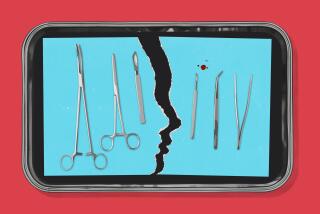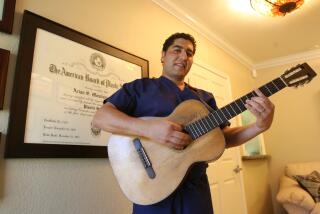Rare Embolism to Blame in Plastic Surgery Death, Lawyer Says
- Share via
LAGUNA NIGUEL — The attorney for plastic surgeon W. Earle Matory Jr. asserted Monday that liposuction patient Judith Fernandez died not because of physician misconduct but because she experienced a rare “fatty emboli shower” that sent fat into her blood and blocked flow to her heart.
Attorney Lloyd Charton of Santa Ana first suggested the alternative cause of death during cross examination of Dr. Aruna Singhania, who performed the autopsy on Fernandez for the Orange County coroner’s office one day after Fernandez died on March 17 in Matory’s outpatient surgery suite in Irvine.
But Singhania and attorneys for the California Medical Board rebutted Charton’s theory, with medical board officials terming it “a red herring.”
The California Medical Board is trying to permanently revoke the medical licenses of Matory and anesthesiologist Robert Hoo, whose patient died after more than 10 hours of surgery for liposuction, brow lift, mini-face lift and laser resurfacing of the skin on her face. The licenses of the two physicians were temporarily revoked in May, pending the outcome of an administrative law hearing, which moved Monday to the Chet Holifield Federal Building here.
Outside court, Charton said he will present testimony showing that the liposuction caused clumps of fat to enter Fernandez’s blood vessels and clog circulation, much like a blood clot. Charton said the surgical devices used to suck the fatty tissue--loosened by a saline solution infused into the body--can help “throw” the fat into the bloodstream.
The defense attorney said he understands such embolisms are rare, that “999 out of 1,000” patients do not experience them. “She was that 1 in 1,000 patient,” he said.
Fernandez had a history of heart problems, use of the diet drugs known as “fen-phen” and extreme weight fluctuations, all of which made her at higher risk for a fatty embolism, Charton said. She had been monitored for an episode of heart arrhythmia and palpitations in 1995, yet concealed those problems from Matory out of fear he would refuse to perform the liposuction, Charton said.
During her testimony about the autopsy, Singhania said Fernandez died of hemodynamic shock, or severe blood loss, and hemodilution, a dilution of the blood. A secondary cause of death was lidocaine toxicity, she testified.
She testified that Fernandez’s heart appeared to be healthy, although it had little blood in it, and it had no valve damage that has recently been linked to use of fen-phen.
Singhania insisted she saw no evidence of fat emboli in the brain, where she said an embolism would have to occur to cause death.
“If a small amount embolized in the heart, that’s not going to cause death,” she testified. “It would have to be in the brain. I looked, and it was not there.”
Charton showed her photographs of microscopic slides of tissue samples--stained to mark any fat cells--prepared independently by a lab for the defense, and asked her to identify the fat masses. Singhania said she could see “black dots” on the photos but would not identify them as fatty emboli because she did not know how the slides had been prepared.
Charton said outside court the slides showed large amounts of fat in the liver, lungs and brain, organs that should not normally have any fat.
Deputy Atty. Gen Richard Hendlin responded that Charton’s fat emboli theory is “irrelevant to the issues. . . . The issue is that Dr. Matory repeatedly and egregiously departed from standards of care.” There were “numerous red flags” during the surgery that should have prompted Matory to stop, he said. Charton’s assertions, he said, are “all part of the [defense’s] side show. So now the patient is at fault?”
More to Read
Sign up for Essential California
The most important California stories and recommendations in your inbox every morning.
You may occasionally receive promotional content from the Los Angeles Times.










